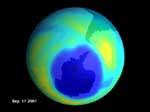|
2001
OZONE HOLE ABOUT THE SAME SIZE AS PAST THREE YEARS Satellite
data show the area of this year's Antarctic ozone hole peaked at about 26 million
square kilometers -- roughly the size of North America -- making the hole similar
in size to those of the past three years, according to scientists from NASA and
the National Oceanic and Atmospheric Administration (NOAA). Researchers have observed
a leveling-off of the hole size and predict a slow recovery.
| |  |
| Image
1 - Level of ozone on September 17, 2001 - maximum levels for this year |
Over
the past several years the annual ozone hole over Antarctica has remained about
the same in both its size and in the thickness of the ozone layer. "This
is consistent with human-produced chlorine compounds that destroy ozone reaching
their peak concentrations in the atmosphere, leveling off, and now beginning a
very slow decline," said Samuel Oltmans of NOAA's Climate Monitoring and
Diagnostics Laboratory, Boulder, Colo. In
the near future -- barring unusual events such as explosive volcanic eruptions
-- the severity of the ozone hole will likely remain similar to what has been
seen in recent years, with year-to-year differences associated with meteorological
variability. Over the longer term (30-50 years) the severity of the ozone hole
in Antarctica is expected to decrease as chlorine levels in the atmosphere decline.
The
total area of the ozone hole is one measure of its severity. The ozone hole area
is defined as the size of the region with total ozone below 220 Dobson units.
A Dobson unit is a unit of measurement that describes the thickness of the ozone
layer in a column directly above the location being measured, a quantity called
the "total column ozone amount." Prior
to the springtime period in Antarctica, when ozone depletion occurs, the normal
ozone reading is around 275 Dobson units. "Last year the ozone hole was of
record size, but it formed very early and then collapsed quickly," said NASA
scientist R.D. McPeters of the Goddard Space Flight Center, Greenbelt, Md. "This
year the hole was about 10 percent smaller." Data
from NOAA's polar-orbiting operational environmental satellites and estimates
of the area made by NASA scientists using measurements from the Total Ozone Mapping
Spectrometer aboard NASA's Earth Probe satellite give similar sizes. Each
spring when the Sun rises over Antarctica, chemical reactions involving chlorine
and bromine from man-made CFCs (chlorofluorocarbons) and bromine-containing compounds
occur in the stratosphere and destroy ozone, causing the "ozone hole."
Measurements of this year's ozone hole made at the South Pole and above the Antarctic
show that atmospheric ozone depletion reached levels typical of the past 10 years. Using
instrumented balloons to make ozone-profile measurements at the South Pole, researchers
from NOAA reported that the September decline in ozone was similar to recent years
with almost all of the ozone in the 15-20 kilometer (9-12 mile) altitude region
destroyed. "Total
column ozone over the South Pole reached a minimum reading of 100 Dobson units
on Sept. 28, 2001, compared to a minimum of 98 Dobson units in 2000," said
Bryan Johnson, a scientist with the Climate Monitoring and Diagnostics Laboratory.
The record low of 88 Dobson units was observed in 1993. "The
severity of the ozone depletion within the hole reached about the same levels
as the past few years and the highly depleted region filled about three-fourths
of the Antarctic polar vortex," said Jim Miller, a scientist with NOAA's
Climate Prediction Center in Camp Springs, Md. "This year the vortex has
been more stable and somewhat colder than average." Year-to-year fluctuations
in the geographical size of the polar vortex and the size of the region with low
temperatures will alter the size of the ozone hole over the next decade during
the period that levels of ozone-destroying chemicals in the atmosphere begin a
slow decline. Thinning
of the ozone layer is a concern because the ozone layer protects the Earth from
harmful effects of the Sun's ultraviolet radiation, which contributes to skin
cancer and cataracts in humans. Total recovery of the ozone layer to levels observed
before 1980 will take at least 50 years, and expected changes in climate, including
a cooler stratosphere, could delay this process. NASA is committed to obtaining
critically important observations to examine and document the recovery of this
life-protecting atmospheric gas. Back
to Top | 


